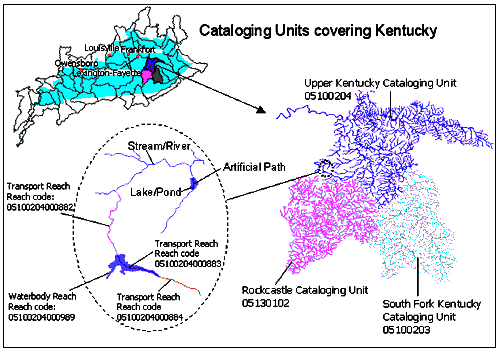
The National Hydrography Dataset
Fact Sheet 106-99 (April 1999)
|| Characteristics of the National Hydrography Dataset
|| Maintaining the NHD
||
|| Obtaining Data from the NHD
|| Information
||

|
In the upper left, the irregular shapes on and around
the shaded image of Kentucky are the hydrologic cataloging units that are in the State of
Kentucky. On the right is a closer high- level view of three cataloging units, showing their
hydrographic features and labeled with the names and numbers of the units. In the oval, a small
area is enlarged to show examples of individual features with their reach codes. Note that the
reach codes incorporate the eight-digit number of the cataloging unit in which they
lie. |
The National Hydrography Dataset (NHD) is a newly combined dataset that provides
hydrographic data for the United States. The NHD is the culmination of recent cooperative
efforts of the U.S. Environmental Protection Agency (USEPA) and the U.S. Geological Survey
(USGS). It combines elements of USGS digital line graph (DLG) hydrography files and the
USEPA Reach File (RF3). The NHD supersedes RF3 and DLG files by incorporating them, not
by replacing them. Users of RF3 or DLG files will find the same data in a new, more flexible
format. They will find that the NHD is familiar but greatly expanded and refined.
The DLG files contribute a national coverage of millions of features, including water bodies
such as lakes and ponds, linear water features such as streams and rivers, and also point features
such as springs and wells. These files provide standardized feature types, delineation, and
spatial accuracy. From RF3, the NHD acquires hydrographic sequencing, upstream and
downstream navigation for modeling applications, and reach codes. The reach codes provide a
way to integrate data from organizations at all levels by linking the data to this nationally
consistent hydrographic network. The feature names are from the Geographic Names
Information System (GNIS).
The NHD provides comprehensive coverage of hydrographic data for the United States.
Some of the anticipated end-user applications of the NHD are multiuse hydrographic modeling
and water-quality studies of fish habitats. Although based on 1:100,000-scale data, the NHD is
planned so that it can incorporate and encourage the development of the higher resolution data
that many users require. The NHD can be used to promote the exchange of data between users
at the national, State, and local levels. Many users will benefit from the NHD and will want to
contribute to the dataset as well.
|| Top || Main Table of Contents ||
Characteristics of the National Hydrography Dataset
It is a feature-based dataset that interconnects and uniquely identifies the stream segments
or "reaches" that make up the Nation's surface water drainage system.
Unique reach codes (originally developed by the USEPA) are provided for networked
features and isolated water bodies
The reach code structure is designed to accommodate higher resolution data.
Common identifiers uniquely identify every occurrence of a feature.
It is currently based on the content of the USGS 1:100,000-scale data, giving it accuracy
consistent with those data.
Data are in decimal degrees on the North American Datum of 1983.
Names with GNIS identification numbers are included for lakes, other water bodies, and
many stream courses.
It provides flow direction and centerline representations through surface water bodies.
|| Top || Main Table of Contents ||
Maintaining the NHD
The NHD is designed to accommodate both the higher resolution data that many users need
and the 1:100,000 scale data. The higher resolution data will be incorporated into the NHD
through the participation of users at the national, State, and local levels. The common
identifiers for the features are the basis for tracking and sharing deletions, additions, and
modifications of features during maintenance. They are used to communicate and share
corrections among organizations. The NHD will improve the integration of hydrographically
related data in support of the varied applications of a growing national user community, and it
will also enable shared maintenance and enhancement.
Obtaining Data from the NHD
The data are now available for downloading by cataloging unit from the USGS at
nhd.usgs.gov. The cataloging unit is a geographic area that
subdivides the accounting units within hydrologic units. Most of the more than 2,100 cataloging
units for the Nation are larger than 700 square miles (1,813 square kilometers).
The data are available in two formats: ARC/INFO workspace and Spatial Data Transfer
Standard. Each format is delivered as tarred and compressed files. Data on compact
disc-readable is available for order through the USGS Global Land Information
System.
Information
More information about the NHD can be found at nhd.usgs.gov.
For information on other USGS products and services, call 1-888-ASK-USGS,
or visit the general interest publications Web site on mapping, geography, and related topics at
erg.usgs.gov/isb/pubs/pubslists/.
For additional information, visit the
ask.usgs.gov Web site or the USGS home page at
www.usgs.gov.
| Top
| Main Table of Contents
| Mapping
Publications
| Eastern Region Geography
| Geography Home |
Any use of trade, product, or firm names is for descriptive purposes only and does not
imply endorsement by the U.S. Government. This document has undergone official review and approval for publications
established by the National Mapping Division, U.S. Geological Survey. Some figures have been modified or
added to improve the scientific visualization of information.

